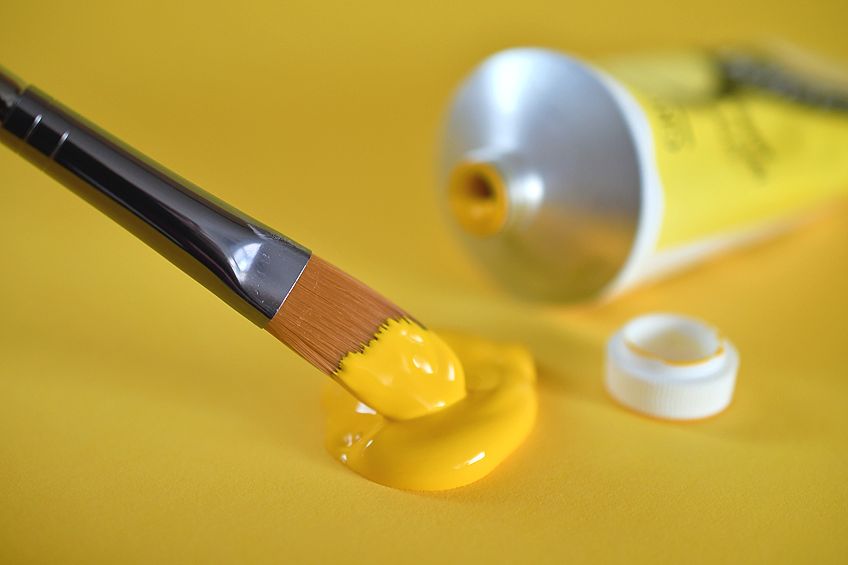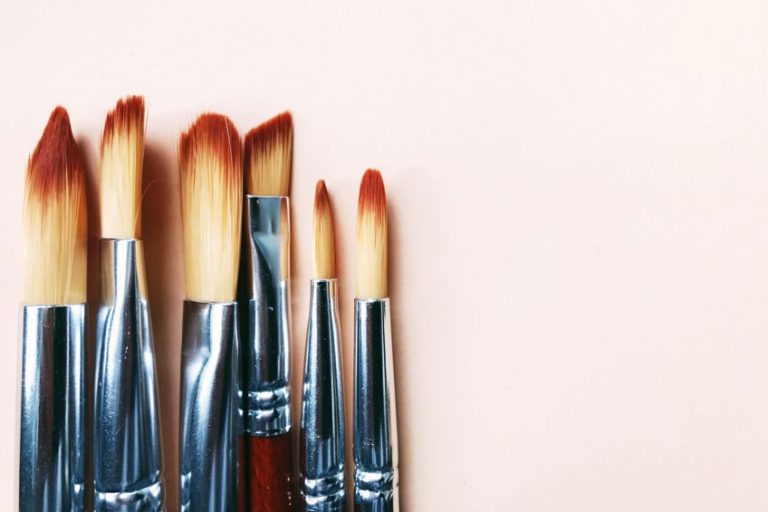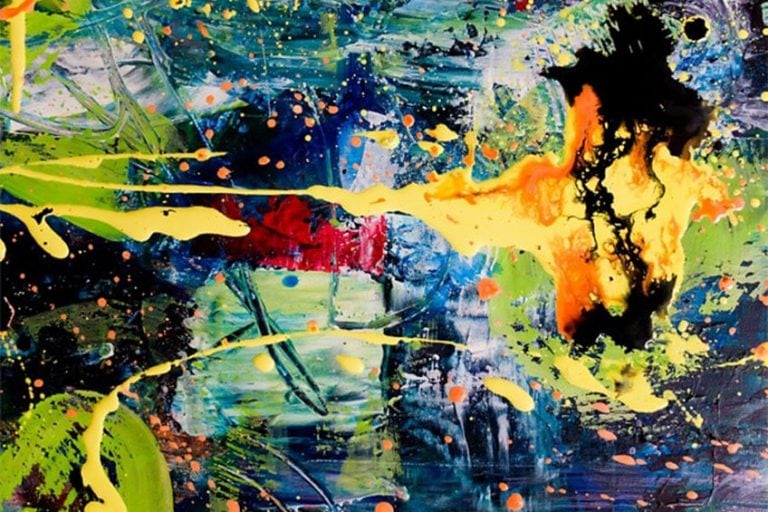What Is Acrylic Paint? – Acrylic Paint Uses, Ingredients, and More
In the art world today, there are countless choices of mediums with which to express our own unique style and creativity. There is everything from acrylics to charcoal, pastels and pencils, and oils and watercolors. In this article, we are going to explore the exciting and colorful world of acrylic paints and the many ways in which they can be used.
What Is Acrylic Paint?
Acrylic paint was developed in Germany in 1934 as a formula of water, acrylic resin, and particles of pigment. The discovery of a paint that had the combined qualities of oils and watercolor paints that could be diluted with water was a groundbreaking discovery. Initially, this radical new paint was sold as house paint, but in the mid-1950s artists began to experiment with it as a possible alternative to oil paints and other artists’ mediums.
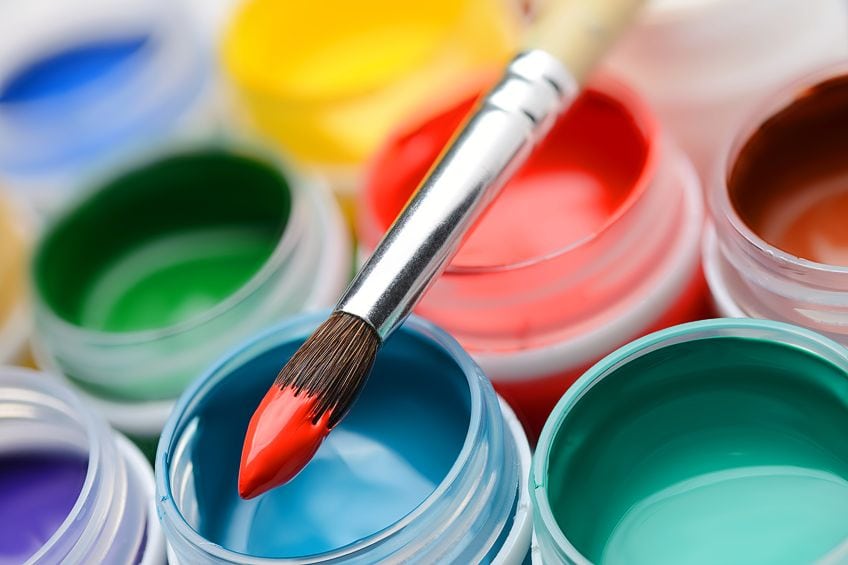
Acrylic Paint Ingredients
Acrylic paint is not a complex paint as it is made of only three ingredients: pigment, an acrylic binder, and what is known as an acrylic vehicle. Let us break down each component and explore it in more detail.
Acrylic Pigment
The pigment is what gives the paint its color. It is made up of small granules that are ground down into tiny particles that are suspended in the paint without dissolving. The pigment can be natural or synthetic, organic or inorganic.
Acrylic Binder
The binder used in acrylic paint is known as an acrylic polymer. It has two roles. The first is to hold the pigment in place when the paint has dried. The second is to form a protective film once the water has evaporated from the paint.
Acrylic Vehicle
In the case of acrylics, water is the vehicle that transports the binder and the pigment. When water combines with the binder, it forms a polymer emulsion. Once the water has evaporated the paint dries to a clear polymer film that contains particles of colored pigment.
Understanding the Science Behind Acrylic Paints
To get a better understanding of acrylic paint uses and how they work, we need to get to grips with the science behind them. Because they are water-based, acrylic paints dry as water evaporates. But there is more to it than that. A few other processes have to take place before the acrylic paint dries and sets.

Step 1: Application
Each portion of acrylic paint that comes out of the tube or jar contains a perfect balance of pigment, acrylic polymer, and water. The water maintains the liquidity of the emulsion and prevents the particles of acrylic polymer from hardening immediately.
Step 2: Evaporation
Once the paint has been applied to the surface on which you are working, a chemical reaction takes place. The pigment that is suspended in the acrylic polymer particles fuses together and starts to dry because it has come into contact with the air.
Step 4: Setting
Another chemical reaction occurs when the pigment is trapped in a hexagonal structure composed of clear polymer particles. The paint dries into a stable, water-resistant film that is permanent and vibrant in color.
Why Are Acrylic Paints So Popular?
In the 70 or so years since artists started using acrylic paints, their popularity has increased exponentially. By now, you might be asking what acrylic paint is used for. Well, they have several uses which we will look into in more detail below. You may have experienced these and additional benefits of acrylic paint yourself.
- The primary reason that acrylic paints are so popular is that they dry so quickly. Thin applications dry within ten minutes. Thicker applications take a bit longer but should be dry within the hour.
- They are simple paints and easy to use. Acrylic paint ingredients are simply the pigment, a binder, and what is known as a vehicle. We will look at these ingredients in more detail in a moment.
- Acrylic paint is made flexible and elastic by the chemicals it contains. That means that the paint will expand and contract as temperatures rise and fall, and will do so without flaking or cracking. Even when the paint has dried fully it will remain flexible.

- Acrylic paint is permanent when it is dry. It is also what is known as lightfast. This means that the colors remain true and do not fade over time, particularly if you are working with artist-grade acrylics. Some of the cheaper student-grade acrylics may lose saturation over time, although they will never fade completely.
Regardless of the grade of acrylic paint you use, it will not yellow with age the way oil paints do.
- Unlike other paint and drawing mediums, you can use acrylic paint on any surface provided there is no wax or oil on it. Besides canvas, paper, and card, you can use acrylics to paint on glass and plastic, metal and stone, fabric, and leather.
- Since acrylic paint is water-soluble, you can wash your brushes and palette, as well as your hands, with soap and water. There is no need for you to use paint thinners or turpentine to clean up. Also, when the paint is dry, it is waterproof.
- Acrylic paints are non-toxic, non-flammable, and do not emit any fumes. This means they are safe for children to use, and they are not harmful to pets.
The Pros and Cons of Acrylic Paints
We have discussed the benefits of acrylic paints in detail, and on the face of it, they appear to be the perfect medium for artists on every level. However, like most things there are positive and negative aspects to acrylic paints, so let us go through the pros and cons one by one.
[su_shadow style=”simple”][su_panel]PROS
- Acrylics dry quickly, which means that you do not have to keep stopping in the middle of a painting to wait for each layer to dry.
- Since acrylics are water-based, you do not require paint thinners or turpentine to clean your hands and your brushes and palette. All you need is soap and water.
- Acrylic paints are extremely versatile and will work on any surface, provided it is free of any wax or oil. So besides canvas, you can use acrylics on paper and cardboard, plastic and metal, glass, wood, and stone.
- Acrylics are flexible in that they can be mixed with a number of different textures and features. You can also slow down the drying time of acrylic paints.
- When the paint dries it becomes water-resistant. It will retain its vibrancy and will not turn yellow over time the way oil paints do. And because acrylics are flexible, they will not peel or crack when dry.
- Acrylic paints are for the most part non-toxic. They are also solvent-free, low-odor, and non-flammable.
CONS
- Because acrylic paints dry so quickly, you cannot take your time with a painting. You have to work fast.
- Once the acrylic is dry it is very difficult to remove it from your brushes and palette, as well as from your nails and skin.
- The colors of acrylic paints will darken as they dry, so your finished painting may look a bit different from when you started it.
- Acrylic paint is frowned upon by some art collectors and galleries who consider it to be “less worthy” than oil paints and watercolors.
Different Types of Acrylic Paints
There are several types of acrylic paints available to artists, by which we mean different thicknesses. However, the consistency of the paint does not have anything to do with its quality or the amount of pigment it contains. The difference is in the acrylic binders that are used. They are gloss, semi-gloss, and matte. An application of a gloss binder makes the paint look transparent. Semi-gloss and matte finishes are translucent and slightly milky when the paint is laid down.
Below is a list of the various acrylic paints available.
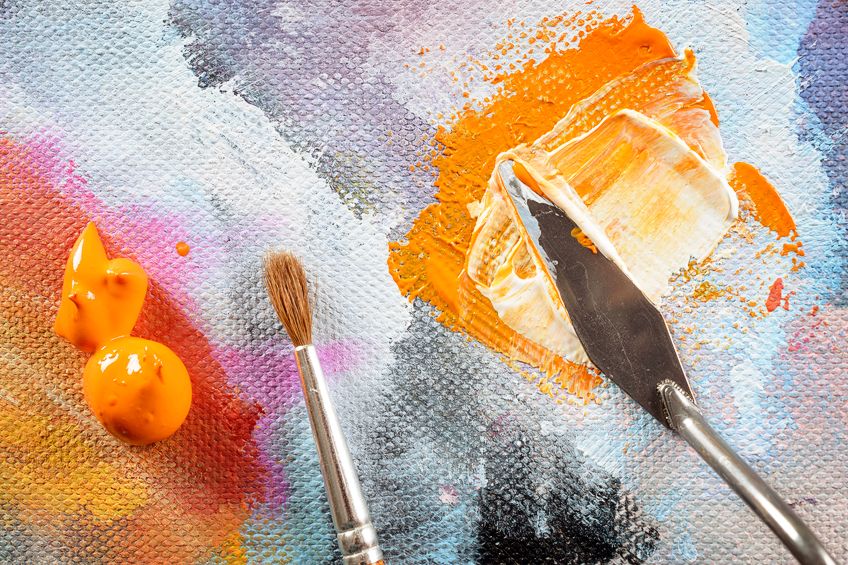
Heavy Body Acrylic Paint
This is the heaviest and thickest of all the acrylics and the most popular with artists. The paint feels like soft butter and is similar to oil paint in that it retains brush marks and strokes. It also works well on rough canvas.
Soft Body Acrylic Paint
As the name suggests, these acrylics are smoother than the heavier-bodied paint and slightly thinner in texture, more like yogurt. Their application is smooth and they are ideal for mixing with various mediums, for example, texture gels, flow improver, and retarding medium, to name a few.
Fluid Paints
Fluid paints come in a bottle rather than a tube and have the consistency of double cream. Fluid paints are perfect for finely detailed work, glazing, and staining, and can even be used in an airbrush and be sprayed onto the surface you are working on.
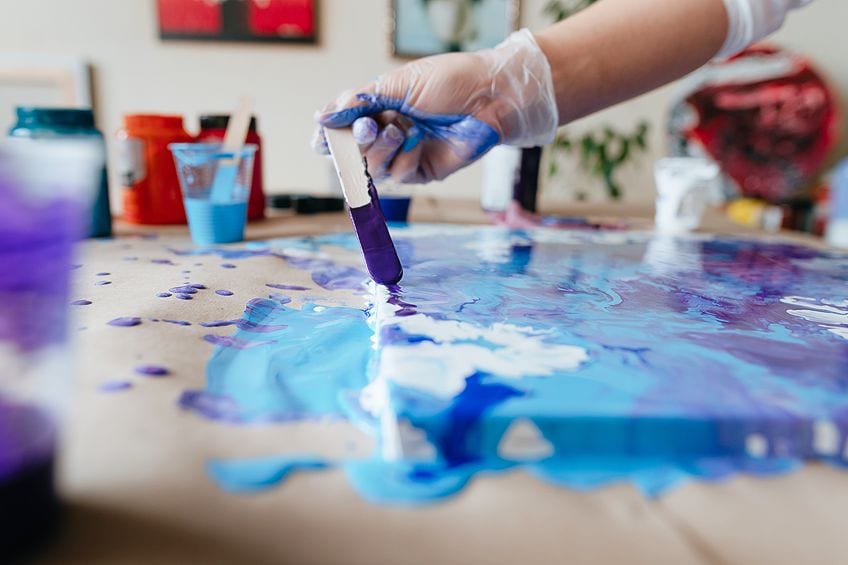
Acrylic Ink
Acrylic ink is even more fluid than the fluid paint mentioned above. The pigment in acrylic ink is ground to a super fine consistency and is suspended in an acrylic emulsion that has the same viscosity as water. This means the paint can be applied with brushes, pens, and airbrushes. The colors of the ink are intense and finish to a high gloss.
Open Paints
These paints are similar to oil paints in that they dry slowly, so you will be able to use the same techniques with them as you would with oils. This includes blending colors on the canvas (or whatever surface you are working on), as well as painting wet-on-wet.
Acrylic Spray Paint
By using spray paint you can cover large areas with thin layers of paint, and at the same time maintain control of how much paint you lay down, either a lot at once or in fine lines. Acrylic spray paints also work well with other types of acrylic paints.
Acrylic Gouache
Acrylic gouache should not be confused with regular gouache as they are very different products. Acrylic gouache is a good choice if you want to put down a large space of flat color, which is what makes it popular with illustrators. As the gouache dries, it levels out the brush marks and dries to a velvety matte finish.
Interactive Acrylics
These acrylics are unique in that although they dry as quickly as other acrylic paints, they can be wet again once dried. The drying time of interactive acrylics can be slowed down as well by adding a few drops of the unlocking formula to the paint.
Getting the Most Out of Your Acrylic Paints
Since the 1950s, the popularity of acrylic paints has continued to increase. Prominent artists such as David Hockney from the UK, and Roy Lichtenstein from the US, were among the first modern artists to use acrylic. These days, many contemporary artists, including American artist Katherine Bernhardt and British artist Lubaina Himid, only use acrylic paints.
But do not be mistaken in thinking that only professional artists can use acrylic paints.
On the contrary, acrylics are ideal for amateur painters, weekend hobbyists, dabblers, doodlers, and even children. Acrylics are not high maintenance paints and you need very few tools to begin with. But before we discuss the tools you will need, let us look at the different grades of acrylics.
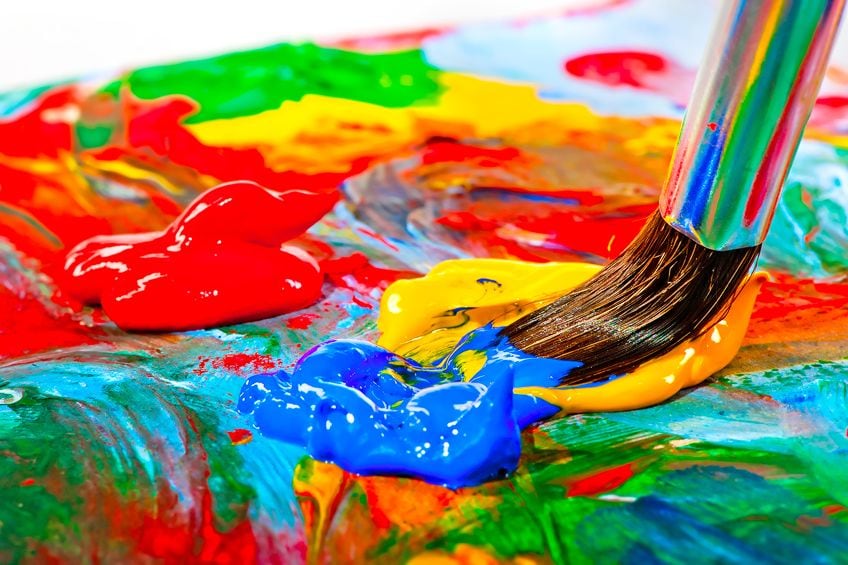
Professional Grade
Needless to say, professional-grade acrylics are the best quality you can get. The pigments and resins are of the highest standard, and the paint itself contains less binder (acrylic polymer). Because of this, the colors are clean and bright, and each color has its own characteristics in terms of opacity and transparency, texture, and drying times.
Also, within the professional ranges, there are different types, or series, of acrylic paints, all of which vary in price. There are also a lot of colors to choose from.
Artist Grade
More often than not, artist-grade acrylic paints contain the same amount of pigment as professional-grade acrylics, but they contain more binder. However, this does not affect the quality of the paint. The only difference between the grades is that the characteristics of artist-grade acrylic paint are not as prominent as those of professional-grade, by which we mean drying times, transparency, and sheen.
Artist-grade acrylics are available in almost as many colors as professional-grade paints.
Student Grade
Student-grade acrylics contain fillers and mediums that add bulk to the paint and extend the pigment. This means that the colors are more transparent and less saturated than professional-grade acrylics. Also, some of the opaque colors in the student-grade range of paints can look chalkier than the higher grade equivalents.
So, the question is, even if you’re a beginner, do you forgo the student-grade acrylic paints in favor of the more expensive ones?
Well, that is entirely up to you, but remember, all acrylic paints, regardless of grade or format, can be used together, so there is nothing preventing you from selecting a few colors from each grade to experiment with.
How to Use Acrylic Paint
It is important that you learn how to apply acrylic paint in order to get the best possible use out of them. In this section, we will look at the ideal colors to use, as well as the most appropriate tools, and, last but not least, how to finish off your painting like a professional.
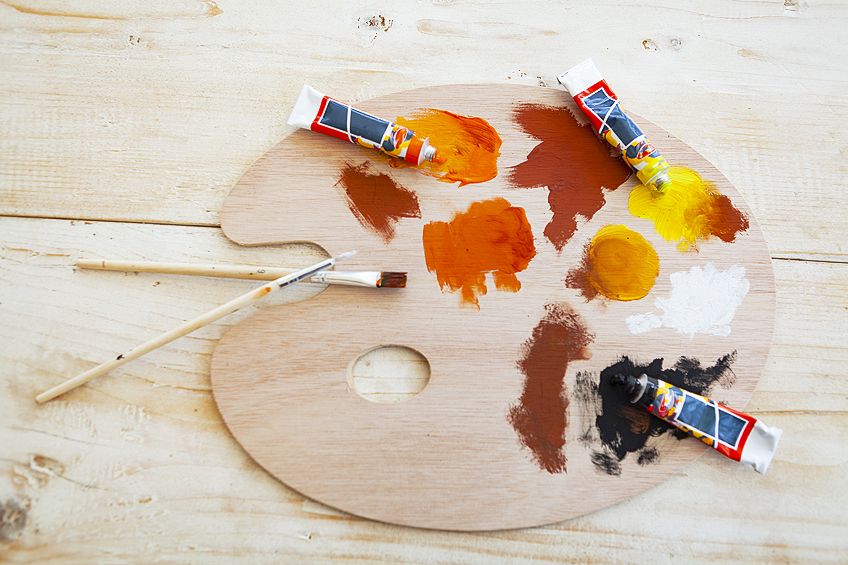
Choosing the Colors of Your Acrylic Paints
With a dizzying array of colors to choose from, it can be hard to know which colors you need, particularly if you are just starting out. You will also find that certain colors are more expensive than others, regardless of which grade they are. This is because certain pigments are harder to get than others. But for the most part, you will find that the earth colors are the cheapest, while the cadmium colors are the most expensive. If you are new to acrylic paints, we recommend that you start with either an acrylic paint set or just the following ten colors.
With these basic colors, you will be able to create a range of colors, so there is no need to worry that you will have a limited palette to work with.
| Shade | Color | Hex | RGB | CMYK |
| Alizarin Crimson | #E32636 | 227, 38, 54 | 0, 83, 76, 11 | |
| Burnt Sienna | #EA7E5D | 234, 126, 93 | 0, 46, 60, 8 | |
| Cadmium Orange | #ED872D | 237, 135, 45 | 0, 43, 81, 7 | |
| Cadmium Red | #E30022 | 227, 0, 34 | 0, 100, 85, 11 | |
| Cadmium Yellow | #FFF600 | 255, 246, 0 | 0, 4, 100, 0 | |
| Dioxazine Purple | #800080 | 128, 0, 128 | 0, 100, 0, 50 | |
| Ivory Black | #000000 | 0, 0, 0 | 0, 0, 0, 100 | |
| Phthalo Blue | #000F89 | 0, 15, 137 | 100, 89, 0, 46 | |
| Phthalo Green | #123524 | 18, 53, 36 | 66, 0, 32, 79 | |
| Titanium White | #FFFFFF | 255, 255, 255 | 0, 0, 0, 0 |
Selecting Your Tools
Contrary to all the paraphernalia you need for oil painting, you need only a few, relatively inexpensive tools for your painting project with acrylics. These are:
- A set of acrylic paints or the paint shades we have listed in the table above.
- A selection of brushes. The best brushes are synthetic rather than natural, as synthetic brushes work better with acrylic paints than natural brushes do. Get yourself a large and small round brush, and a large and small flat brush. These will serve you well to begin with.
- A cup of water in which to rinse your brushes.
- A palette, or even a plate, on which to mix your colors, or just to put down dabs of color so you do not have to keep opening the tubes or jars of paints.
- A palette knife to mix your paints with. A knife works better than a brush because it will not get clogged with paint the way brushes can. Also, stirring the paint as you mix it can damage the brush’s bristles.
- Finally, the surface that you are going to be painting. Make sure it is clean and free of any oil and wax, as well as dust and other small particles.
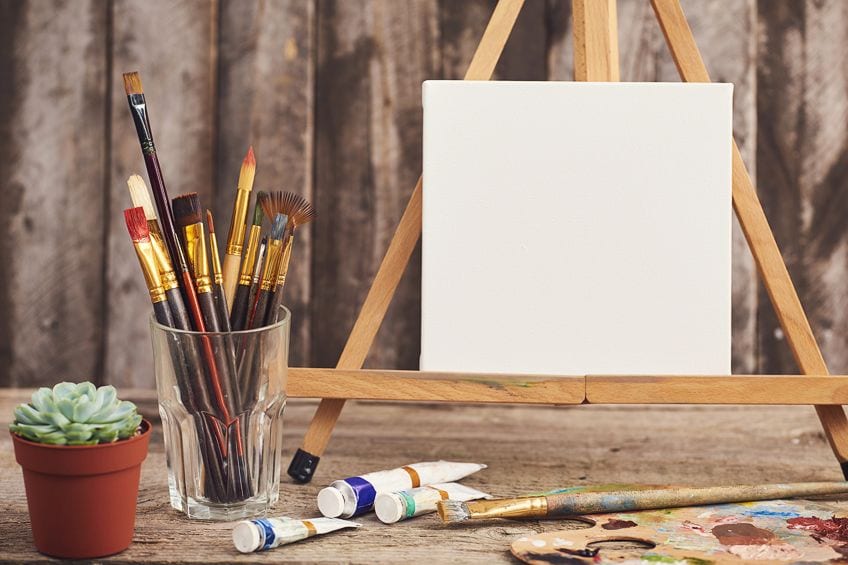
With these few things, you will be ready to embark on your painting project. If you are a beginner you may be surprised at just how quickly acrylics dry, and thus you might be caught unawares. Fortunately, you are able to alter the drying time of your paints, in other words, extend it so your paint stays wetter for longer. All you need to do is add what is known as a retarding medium to your paint.
This will allow you to spend more time on the finer details of your painting, and also enable you to blend different colors on your canvas or palette while the paint is still wet.
Another thing to remember about fast-drying acrylics is that once they have dried, they cannot be liquefied again. So if you need to take a break from painting for a while, make sure that you close the jars or tubes as soon as you have finished with them. If you have paint on your palette you can either cover it with cling film or place it in an airtight container.
The Finishing Touches
Although it is not imperative, you may want to varnish your painting once it has dried completely. Varnish will seal the painting and ensure that the colors maintain their sheen. The fastest drying varnishes available are acrylic varnishes that are made up of polymer resins that have been dissolved in an acrylic emulsion. There are also solvent-based varnishes available, but they are slow-drying. They are made from resins that are dissolved in a solvent.
Whichever varnish you choose, always ensure that your painting is clean and dust-free before you varnish it. Once it has dried completely you can wipe it down with a damp cloth before varnishing it. There are proper varnishing brushes that you can use to apply the varnish, and make sure you layer it thinly and evenly.
When the varnish is semi-dry and feels tacky to the touch, you can prop up the painting against the fall, face inwards, so dust and small particles of debris do not get stuck onto the varnished surface.
How to Make Your Own Acrylic Paint
Although there are numerous grades and colors of acrylic paints available to artists, there is also the option of making your own paints. By doing so, you will be able to create some of your own special colors, and you will also gain a greater appreciation of your craft from start to finish. This is how to make acrylic paint.

Supplies You Will Need
These are the supplies you will need to make your own acrylic paint. They are inexpensive and readily available so you should have no trouble getting them together. You will need:
- Pigment
- Acrylic binder or medium
- Water or clear alcohol
- A steel spatula or a mortar and pestle
- A glass plate or tray
Making the Acrylic Paint
Before you start, it is advisable to put on a mask to cover your nose and mouth to prevent breathing in the fine particles of pigment. Although the ingredients that go into making acrylic paints are non-toxic and solvent-free, we nevertheless recommend that you open the windows and do not allow your pets and children into the room while you are working.
Step 1
Mix the pigment with the water or alcohol in a 50/50 ratio on the glass surface. You can use either water or alcohol, but some artists have found that the pigment disperses more easily in water.
Step 2
Grind the pigment with the spatula or with the mortar and pestle until the pigment is small and even. You may need to experiment by either adding more pigment or more liquid to the mix. If you need to add a bit of water, do so by using an eyedropper. That way there will be no danger in adding too much water.
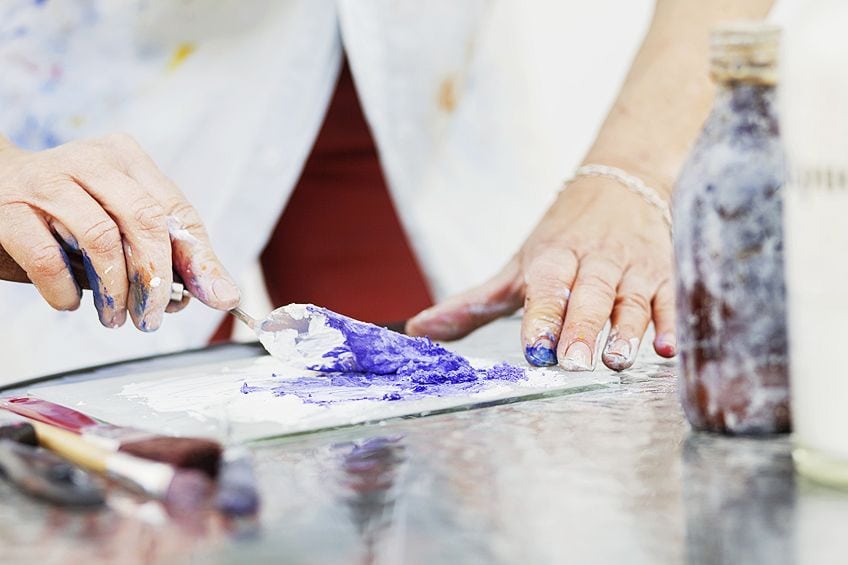
Step 3
Once the pigment is thoroughly ground, carefully add the binder to the mix. Like the water, try not to add too much binder at once. The finished paint will either be matte or glossy on the surface, depending on the type of acrylic binder you have used.
Step 4
Transfer the paint mix into plastic or glass containers and close the lids as tightly as possible to prevent the paint from drying out. Store them in a cool and dry place, ideally out of the reach of children and pets.
As you can see, making your own acrylic paints is a simple process. The beauty of it is that you can mix pigments together to make your own particular colors, ones that no one else may have, and this will only enhance the originality of your paintings.
Now that we have opened up the exciting world of acrylic paint uses, you will have a better understanding of how versatile they are, and just how easy they are to use. Some of you may want to start off by making your own now that you know how to make acrylic paint, and others will want to dive right in and experiment with the various acrylic paint uses. Whatever you decide to do, your palette will be unique to you, just as your masterpiece will be!
Frequently Asked Questions
As a Beginner, Should I Only Buy Student-Grade Acrylic Paints?
Not at all. You can go straight for professional-grade paints if you like, but bear in mind that they are more expensive than student-grade paints. If you are just starting out, we recommend that you experiment with the cheaper paints until you have found which colors and textures work best for you.
Can Acrylic Paints be Used on Other Surfaces Besides Canvas?
Yes, they can. One of the best things about acrylic paints is that they can be used on any surface, including paper and cardboard, wood, glass and metal, fabric, and leather. Just make sure that the surface is clean and free of dust, oil, and wax.
Because Acrylics Dry so Quickly, Does That Mean I Can Only Paint Wet on Dry?
No. On the contrary, acrylic paints are ideal for impasto painting, in other words, thick layers of paint that create texture in your painting. You have to work fairly quickly though, because of the paint’s quick drying time. Alternatively, you can slow down the drying time by adding a retarding medium to the paints, or you could use open acrylic paints. These are similar to oil paints in that they dry slowly.
In 2005, Charlene completed her Wellness Diplomas in Therapeutic Aromatherapy and Reflexology from the International School of Reflexology and Meridian Therapy. She worked for a company offering corporate wellness programs for a couple of years, before opening up her own therapy practice. It was in 2015 that a friend, who was a digital marketer, asked her to join her company as a content creator, and this is where she found her excitement for writing.
Since joining the content writing world, she has gained a lot of experience over the years writing on a diverse selection of topics, from beauty, health, wellness, travel, and more. Due to various circumstances, she had to close her therapy practice and is now a full-time freelance writer. Being a creative person, she could not pass up the opportunity to contribute to the Art in Context team, where is was in her element, writing about a variety of art and craft topics. Contributing articles for over three years now, her knowledge in this area has grown, and she has gotten to explore her creativity and improve her research and writing skills.
Charlene Lewis has been working for artincontext.org since the relaunch in 2020. She is an experienced writer and mainly focuses on the topics of color theory, painting and drawing.
Learn more about Charlene Lewis and the Art in Context Team.
Cite this Article
Charlene, Lewis, “What Is Acrylic Paint? – Acrylic Paint Uses, Ingredients, and More.” Art in Context. September 29, 2021. URL: https://artincontext.org/what-is-acrylic-paint/
Lewis, C. (2021, 29 September). What Is Acrylic Paint? – Acrylic Paint Uses, Ingredients, and More. Art in Context. https://artincontext.org/what-is-acrylic-paint/
Lewis, Charlene. “What Is Acrylic Paint? – Acrylic Paint Uses, Ingredients, and More.” Art in Context, September 29, 2021. https://artincontext.org/what-is-acrylic-paint/.


